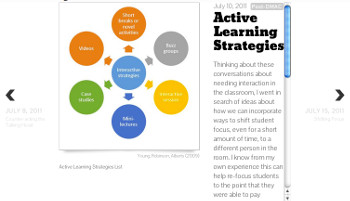Elkie Burnside
Introduction
click here to download a transcript of this video
This essay is a re-creation of my experience seeking funding for, attending, and applying concepts from the 2011 Digital Media and Composition (DMAC) Institute. My intention is to share my journey as a professional writer working with digital, multimodal technology for content delivery in a technical training environment. I have chosen a blog-like format via Timeline JS to allow the main narrative and different multimodal artifacts created in this process to reside in the same space. My desire in sharing this glimpse into my experience is to show others how the principles emphasized at DMAC can be applied outside of the classroom and work toward breaking down the academic-theory/industry-practice divide that we encounter from time to time.
Author Profile
At the time of writing these entries the author was both a full time PhD student at Oklahoma State University (OSU) and an employee making the transition from part-time to full-time employment at Fire Protection Publications, also housed at OSU.
The bare bones of what Fire Protection Publications does is that it produces training materials for the fire and emergency services professions. It is a really fascinating process of combining the national standards (published by the National Fire Protection Association) with the expertise of International Fire Service Training Association (IFSTA) members. FPP employees work with IFSTA committee members in order to produce both the training manual and other instructional materials. It is pretty complex, but the part that most directly effects the project I am working on is the type of instructional materials that are provided for instructors who adopt the IFSTA manual for a specific class. For each manual that is approved for a curriculum FPP produces a core package that consists of the following components:
- Lesson outline – Contains the core learning objects, manual content, and review questions for each chapter
- PowerPoint® (PPT) presentation – Visualizes the content of the lesson outline
- Chapter Quiz – Assesses in 10-15 questions the core learning objectives
- Chapter Test – Assesses the core learning objectives in a longer format than the quiz
- Workbook – Provides students with a self-paced tool to review chapter content
Curriculum packages may also include several optional pieces of information. These consist of an exam prep (provides certification test preparation), skill evaluation checklists (gives instructors assessment tools correlated to the psychomotor skill sheets in the manual, these activities have a specific step-by-step sequence), and learning activities (provides activities to review and reinforce cognitive skills that do not have one way to accomplish the goal).
Timeline Blog
click here to download a transcript of the instructor video: IFSTA curriculum (7/10/12)
click here to download a transcript of the student video: IFSTA interactive learner (7/25/12)
Final Reflection
The experience of creating, piloting, establishing a style, and then finally promoting these changes to customers for this PPT revision incorporated many methods of communication. Not only was a user-needs analysis required while creating the new style, but I also had to consider instructional developers’ needs as well. In addition, disseminating the reasons and advantages of these changes to FPP customers was an important step in this seemingly small change in the entire curriculum package. Critics who argue that multimodal composing does not require the depth of understanding that alphabetic texts require should reconsider this position. While not every multimodal text will depend on such an intense process for creation, implementation, and production, many texts will require some form of these activities (just like the alphabetic texts so often privileged in academic writing environments). My participation in DMAC helped me bring new understanding about accessibility and the importance of a rhetorically based design approach to this project. Without these discussions I am not sure if the newly revised style would have been as successful as it is now.
Author

Elkie Burnside is an Assistant Professor of English at The University of Findlay in Ohio. Her research interests center on multimodality, rhetoric, and instructional methods in academic and professional settings. Elkie also serves as an Assistant Editor for Kairos.
